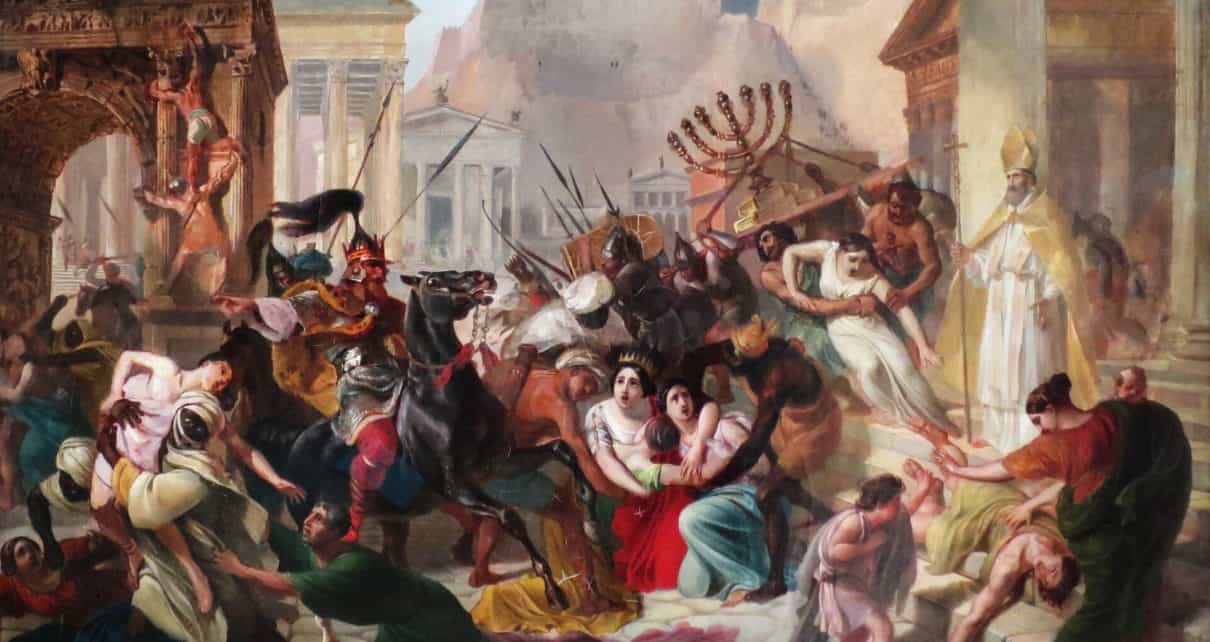So powerful was the Empire as it basked in wealth and affluence that nothing seemed to jeopardise its existence. Ironically, it was its prosperity and the accompanying sense of security that was to bring on its own demise….
The Romans encouraged immigration, letting the newcomers into their domain to perform jobs which they themselves were reluctant to undertake. The procedure concerned military service as well. The initial streams of immigrants pouring into the Roman Empire mainly from the North inhabited by barbarian Germanic tribes soon turned into rivers. At the critical moment, it was not only the newly arrived foreigners, but also first- and second- generation immigrants that eagerly joined the invaders’ ranks.
The turning point in Europe’s history arrived when the Huns appeared on the eastern fringes of the continent. The Huns, the steppe nomads, inspired terrible fear throughout Europe and came to symbolize savagery and cruelty. This is how they are depicted in Jordanes’ writings:
“On entering Scythia, they immediately sacrificed all the Scythians they encountered to Victory. The reminder were enslaved and subjugated. No sooner had the Huns crossed the Maeotic swamp than they fell upon the Alpidzuri, the Alcildzuri, the Itimari, the Tuncarsi and the Boisci like a whirlwind of nations. The Alani equal in battle but completely different in terms of civilisation, manners and appearance were soon subdued in the aftermath of the Huns’ unceasing assaults. Their terrifying features invoked fear of those whom they probably did not even surpass in war. They spread terror because of their appearance: fearfully swarthy and, if I may say so, with a sort of shapeless lump in place of a head and with pin-holes instead of eyes. Their awe-inspiring aspect betrays a hardy soul. Their hardihood manifests itself in the cruelty towards their own children from the very day they are born. They are known to cut the cheeks of their newly born males with iron swords so that they should learn to cope with the future wounds before they receive the nourishment of their mothers’ milk. Therefore they grow old beardless and come of age without comeliness as each iron-furrowed face prevents the growth of the youth’s natural beauty of stubble. Although short in stature, they are unparalleled as horsemen, quick and flexible in bodily movement. Broad- shouldered, they skilfully wield bow and arrow. They have firm-set necks, which are always erect with pride. Outwardly human, they lead the cruel lives of wild beasts.”
Ammianus Marcellinus, Roman commander and chronicler, the author of an outstanding historical work intended as the continuation of Tacitus’ “History” comprising the period of between 98 and 378, offers the following description of Hunnic customs:
“At the very moment of birth the cheeks of their male infants are deeply marked with an iron tool so that the resultant scars could stop facial hair from appearing when the boys grow up. Like eunuchs, they grow old beardless. Unsightly beyond imagination, strong-limbed, plump-necked and bow-legged, they resemble two-legged beasts or these human-faced posts hewn out crudely with an axe at the end of bridges. They are in no need of fire or condiments. Instead, they live on the roots of wild plants or on the half-raw animal flesh, which they place between their own thighs and the backs of their horses in order to warm it. Never do they enter roofed houses, which they avoid just like we would shun sepulchres. Consequently, not even one reed-thatched tent can be found in their abodes.. From their very cradles they keep roaming over the mountains and forests in order to get used to enduring frost, hunger and thirst. Not even in foreign lands will they enter a roofed house unless pressed by necessity since they believe that a roof does not provide security. Their garments consist of linen rags or pieces of mouse skins sewn together. They have one outfit serving as both formal and informal attire. Once they put on their grey shirts, they only take them off or change when they disintegrate out of dirt. Round caps are used to cover their heads and goat skins serve to clothe their hairy legs. Their shoes, not made or repaired with the help of a cobbler’s last, hinder them from stepping comfortably. That is why they are not cut out for fighting on foot; indeed, they are attached to their horses – resistant yet unsightly animals. Sometimes they mount them in female fashion and thus solve the problem of their daily needs. They spend days and nights on horseback. It is on horseback that they buy and sell, consume their meat, drink and recline on the narrow neck of their steed only to fall into a deep slumber.
And to deliberate any weighty matter, the common council is held on horseback as well. Not being under kingly authority, they are contented with the irregular government of their chiefs, and under their lead they force their way through all obstacles.
They go into battle in wedge formation uttering all kinds of wild yells. Swift and agile, they can deliberately disperse only to reunite in order to launch an attack. And as they do not move in a solid body, they can scatter and carry out massacres over vast areas. However, they are never seen storming fortifications or ransacking enemy camps as their main priority is fleetness.
They are the most formidable warriors imaginable. First, at a distance they hurl their spears tipped with sharpened bones fastened into the shafts with amazing skill. Immediately afterwards they gallop towards their antagonists at close quarters and fight with the sword with no regard for their own lives. And once their opponents’ attention has been entirely focused on warding off their blows, they immediately entangle their enemies with twisted cords to block any bodily movement. The Huns do not plough and do not even touch a plough-handle. With no permanent abode, they are akin to constant fugitives. Their wagons are their homes. There their wives weave their repulsive garments, there they consociate and bring up their children until they reach puberty. Therefore, none among them can say where his home is as he has been conceived in one place, born in another and brought up in yet another one. In truce they are not to be trusted due to their fickle disposition and propensity for every breeze of any hope, ready to sacrifice a lot in order to yield to an unexpected fit of fury. Much the same as brute beasts, they are incapable of distinguishing between right and wrong. Their speech is ambiguous and obscure and there exists no superstition or religion that they are inhibited by. However, they are consumed by insatiable greed for gold”.
In 375 AD the Huns overrun the land of the Ostrogoths thus becoming the most powerful people in this part of the world. This is how Jordanes depicts the defeat of the Ostrogoths by the Huns:
“Having seen a tribe of supreme warriors, the oppressors of numerous peoples, the Goths take fright and together with their king deliberate on how to evade the enemy.
At the news of the Huns’ incursion, King Ermanaric of the Goths is so stupefied that despite his previous triumphs over various tribes, he lets himself be deceived by the once loyal and now treacherous Antes. When, Svanhild, a woman coming from the Antes and married to Ermanaric betrayed the king with his own son, Ermanaric had her tied to wild horses and torn apart. Svanhild’s death was avenged by her brothers, Sarus and Ammius, who pierced Ermanaric’s side with spears. Ermanaric never recovered from the wound and his subsequent life was reduced to vegetation.
When word about his poor health spreads, Balamber, the King of the Huns takes advantage of the situation. Thus he gathers his troops and invades the lands of the Ostrogoths abandoned by the Visigoths, their former allies. In the face of these dramatic events, Ermeneric with his health sapped by the wound, advanced in age and increasingly concerned about the Hunnic invasion gives up the ghost at the age of 110. His death enabled the Huns to gain the upper hand over the eastern fraction of the Goths known as Ostrogoths. The western group called Visigoths kept deliberating on what to do in the face of the Hunnic onslaught. Eventually, they resolved to send envoys to Romania to ask Emperor Valens, the younger brother of Emperor Valentinian I, to grant them part of either the Province of Thrace or that of Moesia whose lands they wished to cultivate. In return for the favour, they undertake to comply with his laws and obey his orders. They also pledge to convert to Christianity if the Emperor is willing to send them preceptors with fluent command of the Gothic tongue. Filled with joy, Valens accepts what he himself eagerly anticipated. . Letting the Goths into Moesia resembled a symbolic wall protecting his domain from the other tribes’ designs against him”.
Thus the Ostrogoths succumbed to the invaders whereas the Visigoths, determined not to suffer the same fate, abondoned their abodes and with all their belongings crossed the Danube and settled on Roman lands.
It was not long, however, before a violent conflict arose between the Romans and the newcomers. On 9th August 378 AD during the Battle of Adrianopole, the Visigoths defeated the Roman troops led by Emperor Valens, who was killed during the encounter. For several decades, the Visigoths roamed over the Roman territories plundering and looting. In 410 they sacked Rome and then settled in Gaul acknowledging the Emperor’s authority in name only. The political, economic and social order established over the centuries was now falling apart like a house of cards.
Before the Goths’ arrival in Gaul, a great number of peoples had successfully entered the country. Aware of the Huns approaching and emboldened by the decline of the Roman Empire, an increasing number of hitherto unknown barbarian peoples resolved to abandon their existing territories in order to settle on Roman lands. The first to migrate were the Vandal tribes known as the Hasdingi and the Silings as well as the Alans (most probably the Iazyges – the Alans’ western ramification). The Suebi people also tend to be mentioned as one of the migrating tribes yet this does not find full support in historical sources. On the contrary, the records point to the Quadi people inhabiting areas of Slovakia and Moravia.
It is unclear whether the Hasdingi under their King Godegisel, the Silings and all the above mentioned tribes deserted their existing territories simultaneously or whether their unification materialised during the invasion of Gaul or just before. This notwithstanding, on the last day of the year 406, the barbarians crossed the frozen Rhine into Gaul. The Burgundians might have been yet another tribe to take part in the invasion as it is to them that Emperor Constantius III ceded the part of Gaul situated on the River Rhine in 413.
Even though the Huns did invade what is Poland today, few details of the conquest are known. Their presence is attested by archeological sources. In the village of Jakuszowice (southern Poland), a burial mound of a Hun warrior was discovered along with the gold plates of an Asian bow (probably symbolising authority exercised on someone else’s behalf). A Hunnic grave of a woman was unearthed in Jędrzychowice near Wrocław. The grave contained gold ornaments and a bronze Hunnic cauldron. In the village of Przemęczany (southern Poland), archaeologists came across a skeleton of a warrior with the skull deformed in accordance with the common Hunnic practice .
The Hunnic invasion of what is contemporary Poland might explain why the peoples living there at the time fled their settlements en masse burying treasures. In some cases, the evacuation clearly took place amid chaos and panic. In the village of Igłomia near Krakow, the fugitives left their pottery kilns unextinguished. One such kiln contained the earthenware consisting of 92 pots.
The wealthy provinces of the crumbling Imperium Romanum kept falling into the clutches of the ever-growing number of invaders. This is what St. Jerome recorded in those days:
“The entire Gaul fell prey to innumerable savage tribes. The area between the Alps and the Pyrenees as far as the Ocean and the Rhine was plundered by: the Quadi, the Vandals, the Sarmatians, the Alans, the Gepids, the Heruli, the Saxons, the Burgundians, the Alemanni and, o you wretched republic! – our foes – the Pannonians.”
In 409, the Vandals, the Alans and the Suebi left Gaul for Spain, which they then divided among themselves by drawing lots. Accordingly, the Alans obtained Lusitania and Carthaginensis, the Silings received Baetica, Hasdingi gained East Gaul whereas the Suebi acquired West Gaul.
Between 416 and 418, the Silings were wiped out by the Visigoths, allied with Rome at the time. The King of the Silings, Fredebal was captured and sent to the imperial court in Ravenna. The few Silings who weathered the storm associated with the Hasdingi thus losing their original identity.
In 429 the Vandals and the Alans under the command of Gaiseric, the King of the Vandals moved to Northern Africa. In June 430 they laid siege to Hippo, which surrendered after a 14-month-long besiegement. In 432 the Emperor sent an expeditionary force to Africa, which, however, suffered a total defeat at the hands of the Vandals.
In the coming decades, the kingdom established by the Vandals in Africa played a major political role in the western part of the Mediterranean basin. The Vandals conquered a number of islands in the Mediterranean Sea including Sardinia and Corsica as well as Sicily (temporarily). In 455 they sacked Rome.
Tłum. A. Sz.
[Wróc do tekstu w języku polskim]
Podoba Ci się to co robimy? Wesprzyj projekt Magna Polonia!






